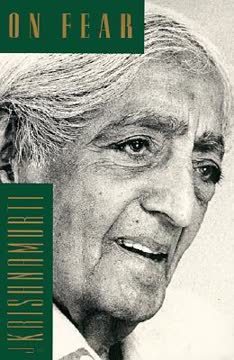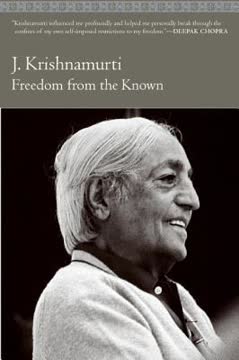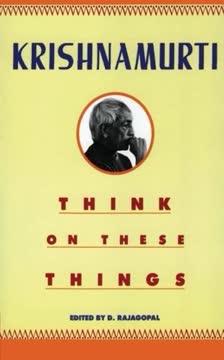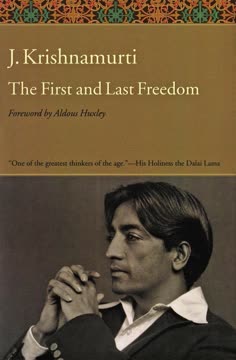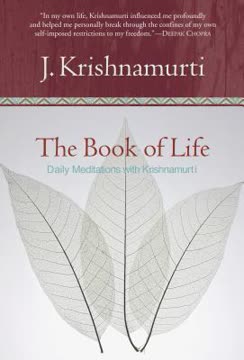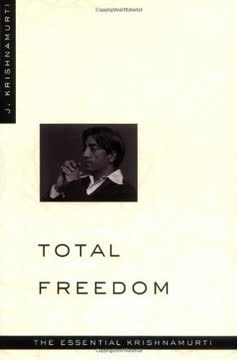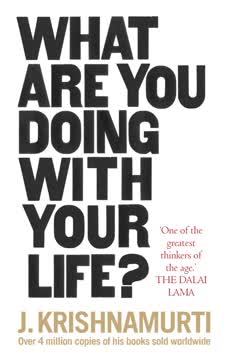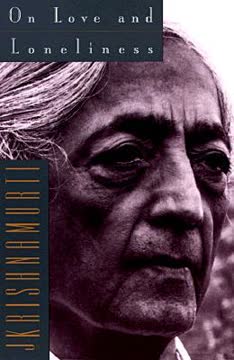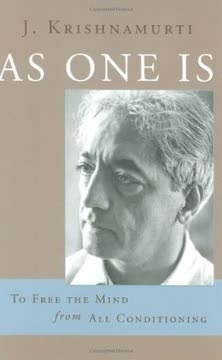Key Takeaways
1. Fear is a Creation of Thought and Time
Thought itself is the source of fear.
Rooted in Past and Future. Fear isn't an inherent reality but a construct of the mind, deeply intertwined with our perception of time. It arises from dwelling on past experiences or projecting into future uncertainties. This mental dance with what was or might be distracts us from the present, where fear has no actual hold.
Thought's Role. Thought, in its essence, is the mechanism that sustains fear. It replays past traumas, imagines future threats, and thus keeps the cycle of fear alive. Without thought's interference, the immediacy of the present moment offers a space free from fear's grip.
Breaking the Cycle. Recognizing that fear is a product of thought and time is the first step toward liberation. By understanding this connection, we can begin to disentangle ourselves from the mental patterns that perpetuate fear, allowing us to live more fully in the present.
2. The Observer is the Observed: Dissolving the Division
Is the observer who says ‘I am afraid’ any different from the thing observed, which is fear?
The Illusion of Separation. We often perceive ourselves as separate from our fears, as if there's an "I" that is experiencing fear as an external entity. This division creates a sense of conflict, where we're constantly trying to manage or overcome our fears. However, this separation is an illusion.
Interconnectedness. The observer and the observed are, in reality, one and the same. The "I" that is experiencing fear is not separate from the fear itself; it is an integral part of it. This realization is crucial because it dissolves the conflict and allows for a deeper understanding of fear.
Total Acceptance. When we recognize that we are not separate from our fears, we can approach them with a sense of acceptance and compassion. This doesn't mean we condone or embrace fear, but rather that we acknowledge it as a part of ourselves, allowing us to observe it without judgment or resistance.
3. Attention Dissolves Fear: The Power of Present Awareness
When there is complete attention there is no fear.
The Antidote to Fear. Attention, particularly in the present moment, is the most potent antidote to fear. When we are fully present and attentive, we are not dwelling on past regrets or future anxieties, the breeding grounds of fear.
Total Immersion. Complete attention requires a total immersion in the present, where we are fully engaged with our senses and experiences. This state of awareness leaves no room for the mental chatter that fuels fear.
Mindfulness. Cultivating mindfulness through practices like meditation can help us develop the capacity for sustained attention. By training our minds to stay present, we can gradually weaken the grip of fear and cultivate a sense of inner peace.
4. The Illusion of Security: Understanding Our Deepest Desires
Fear begins and ends with the desire to be secure.
The Root of Fear. The desire for security, both inward and outward, is a fundamental human drive. However, this desire can also be a source of fear, as we become anxious about losing what we have or not being able to attain what we want.
The Impermanence of Life. The pursuit of security is often futile because life is inherently impermanent. Everything is subject to change, and clinging to the illusion of permanence only leads to greater suffering.
Embracing Uncertainty. True freedom from fear comes from accepting the uncertainty of life and letting go of the need for control. This doesn't mean we should be reckless or irresponsible, but rather that we should cultivate a sense of inner resilience that allows us to navigate life's challenges with grace and equanimity.
5. Thought, Pleasure, and Fear: An Interconnected Web
Both pleasure and pain cause fear.
Two Sides of the Same Coin. Pleasure and fear are not opposing forces but rather two sides of the same coin, both sustained by thought. The pursuit of pleasure often leads to the fear of losing it, while the avoidance of pain can create anxiety and apprehension.
The Trap of Desire. Desire, whether for pleasure or to avoid pain, is a trap that keeps us bound to the cycle of fear. By understanding this connection, we can begin to disentangle ourselves from the desires that perpetuate our suffering.
Beyond Duality. True freedom lies in transcending the duality of pleasure and pain, fear and desire. This requires a shift in perspective, where we no longer seek to control our experiences but rather embrace them with equanimity and acceptance.
6. Freedom from Fear: A Total Transformation
Unless you are free from fear, you can’t think, feel, or live properly.
A New Way of Being. Freedom from fear is not merely the absence of anxiety but a total transformation of our being. It's a state of liberation that allows us to think clearly, feel deeply, and live authentically.
Breaking Free. This transformation requires a willingness to challenge our deeply ingrained beliefs and patterns of behavior. It's a journey of self-discovery that demands courage, honesty, and a commitment to truth.
The Path to Liberation. By understanding the nature of fear and its connection to thought, time, and desire, we can begin to dismantle the mental structures that keep us bound. This process leads to a profound sense of freedom and allows us to live with greater joy, peace, and purpose.
7. The Importance of Self-Knowledge: Seeing What Is
Self-understanding is the awakening and ending of fear.
The Foundation of Freedom. Self-knowledge is the cornerstone of freedom from fear. By understanding our own thoughts, emotions, and motivations, we can begin to unravel the patterns that perpetuate our suffering.
Honest Introspection. This requires honest introspection, where we are willing to confront our deepest fears and insecurities without judgment or self-deception. It's a process of self-discovery that demands courage and vulnerability.
The Power of Awareness. As we gain greater self-knowledge, we become more aware of the triggers that activate our fears. This awareness allows us to respond to these triggers with greater wisdom and compassion, rather than reacting out of habit or conditioning.
8. Beyond Fear: Love, Compassion, and Intelligence
When fear ceases, then the power to breed illusion, myth, and visions, with their hope and despair, also ceases, and then only begins a movement of going beyond consciousness, which is thought and feeling.
The Fruits of Freedom. Beyond fear lies a realm of love, compassion, and intelligence. These qualities are not merely emotions but rather fundamental aspects of our being that are obscured by fear.
Unconditional Love. Love, in its purest form, is unconditional and boundless. It extends to all beings, without judgment or discrimination. This love is not dependent on external circumstances but rather flows from a deep wellspring of inner peace and acceptance.
The Path to Wisdom. Compassion arises from a deep understanding of the suffering of others. It's a recognition that we are all interconnected and that our actions have a ripple effect on the world around us. Intelligence, in this context, is not merely intellectual prowess but rather a wisdom that guides us toward actions that are aligned with love and compassion.
Last updated:
FAQ
1. What is "On Fear" by J. Krishnamurti about?
- Exploration of Fear: The book is a deep inquiry into the nature, causes, and effects of fear in human life, both at the individual and collective level.
- Psychological vs. Physical Fear: Krishnamurti distinguishes between natural, physical fears (like danger) and psychological fears (such as fear of failure, loneliness, or death).
- Ending Fear: The central theme is whether it is possible to be totally free from fear, not just manage or suppress it.
- Self-Knowledge and Observation: The book emphasizes the importance of self-knowledge, direct observation, and understanding the movement of thought as the path to freedom from fear.
2. Why should I read "On Fear" by J. Krishnamurti?
- Universal Relevance: Fear is a fundamental human experience, and Krishnamurti’s insights are applicable to anyone seeking to understand and transcend it.
- Practical Wisdom: The book offers practical approaches to observing and understanding fear, rather than providing mere theoretical explanations or techniques.
- Transformative Potential: Krishnamurti suggests that true freedom from fear can lead to a radically different, more creative and compassionate way of living.
- Challenging Conventional Solutions: The book questions traditional methods like analysis, suppression, or seeking help from authority, encouraging readers to look within for answers.
3. What are the key takeaways from "On Fear" by J. Krishnamurti?
- Thought Breeds Fear: Psychological fear is largely a product of thought, memory, and the projection of past experiences into the future.
- No Division Between Observer and Fear: The observer (the one who says "I am afraid") is not separate from fear; realizing this is crucial to ending fear.
- Attention Dissolves Fear: Complete, choiceless attention to fear—without escape, suppression, or analysis—can bring about its ending.
- Freedom from Fear is Possible: Krishnamurti asserts that it is possible to be totally free from fear, not just manage or reduce it.
4. How does J. Krishnamurti define fear in "On Fear"?
- Psychological vs. Physical Fear: Physical fear is a natural response to danger, while psychological fear arises from thought, memory, and anticipation.
- Fear as a Movement of Thought: Fear is seen as a movement away from "what is"—the actual fact—towards imagined outcomes or memories.
- Fragmentation and Comparison: Fear is often rooted in comparison, conformity, and the desire for security or certainty.
- Fear as a Product of Time: The book links fear to the psychological movement of time—thinking about the past or future.
5. What are the main causes of fear according to "On Fear" by J. Krishnamurti?
- Thought and Time: The projection of past experiences and anticipation of the future by thought is a primary cause of fear.
- Desire for Security: The search for psychological security, certainty, and permanence breeds fear.
- Comparison and Conformity: Comparing oneself to others and conforming to ideals or societal expectations generates fear.
- Escapes and Avoidance: The tendency to escape from or avoid facing fear directly actually sustains and increases it.
6. What is Krishnamurti’s method for ending fear in "On Fear"?
- Direct Observation: He advocates observing fear without judgment, analysis, or the desire to change it.
- No Escape or Suppression: Facing fear directly, without trying to escape, suppress, or rationalize it, is essential.
- Understanding the Observer: Realizing that the observer is not separate from fear dissolves the division and the conflict.
- Total Attention: Bringing total, choiceless attention to the fact of fear allows it to end naturally.
7. How does "On Fear" by J. Krishnamurti address the role of thought and time in fear?
- Thought as the Source: Thought, based on memory and knowledge, creates psychological fear by projecting past pain or pleasure into the future.
- Time as Psychological Movement: Psychological time—thinking in terms of "what was" and "what will be"—is inseparable from fear.
- Ending the Cycle: Understanding the movement of thought and time is key to ending fear, as fear cannot exist in the actual present moment.
- Observation Without Time: Observing fear without the interference of past knowledge or future anticipation is central to Krishnamurti’s approach.
8. What does Krishnamurti say about the relationship between fear and pleasure in "On Fear"?
- Two Sides of the Same Coin: Fear and pleasure are deeply interconnected; the pursuit of pleasure inevitably brings about fear of its loss.
- Thought Sustains Both: Thought sustains both pleasure and fear by remembering pleasurable experiences and fearing their end.
- Cycle of Reward and Punishment: Human consciousness is caught in the cycle of seeking pleasure (reward) and avoiding pain (punishment), which perpetuates fear.
- Freedom Beyond Both: True freedom, according to Krishnamurti, is beyond both pleasure and fear, requiring the understanding of their relationship.
9. How does "On Fear" by J. Krishnamurti critique traditional approaches to overcoming fear, such as analysis or seeking help?
- Analysis is Fragmentary: Krishnamurti argues that analysis divides the observer and the observed, which perpetuates conflict and does not end fear.
- Time Consumes Change: Analysis takes time, and during that time, new fears and complications arise, preventing true resolution.
- Dependence on Authority: Seeking help from gurus, psychologists, or religious authorities creates dependence and does not lead to self-understanding or freedom.
- Direct Perception Needed: Only direct, immediate perception of fear—without intermediaries or methods—can bring about its ending.
10. What is the significance of the observer and the observed in "On Fear" by J. Krishnamurti?
- Illusion of Separation: The book emphasizes that the observer (the "I" who observes fear) is not separate from the observed (fear itself).
- Division Breeds Conflict: The division between observer and observed creates conflict, resistance, and perpetuates fear.
- Ending the Division: Realizing that the observer is the observed dissolves the conflict and allows for the total ending of fear.
- Key to Transformation: This insight is central to Krishnamurti’s teaching and is presented as the key to psychological transformation.
11. What are some of the most important concepts and terms explained in "On Fear" by J. Krishnamurti?
- Choiceless Awareness: Observing fear or any psychological state without choice, preference, or interference from past knowledge.
- Psychological Time: The mental movement from past to future, which is distinct from chronological time and is a root of fear.
- Total Attention: A state of complete, undivided attention in which fear and its causes can be seen clearly and dissolved.
- Fragmentation: The tendency of thought to divide experience into parts (observer/observed, past/future), which sustains fear and conflict.
12. What are the best quotes from "On Fear" by J. Krishnamurti and what do they mean?
- "When there is complete attention there is no fear." – This means that in a state of total awareness, fear cannot exist; fear arises in inattention and avoidance.
- "Thought itself is the source of fear." – Krishnamurti points out that psychological fear is created and sustained by thought, especially when it projects past experiences into the future.
- "The observer is the observed." – This central insight means that the one who experiences fear is not separate from fear itself; realizing this ends the conflict and division.
- "To be aware of and learn about fear in oneself is not to interpret that feeling in words, for words are associated with the past, with knowledge." – True understanding of fear comes from direct observation, not from labeling or analyzing it through the lens of past experience.
- "When you see the causation, or many causes, then that very perception ends the cause." – Direct perception of the root of fear brings about its ending, without the need for gradual change or external help.
Review Summary
Readers find On Fear insightful and profound, praising Krishnamurti's approach to understanding fear through observation and awareness. Many appreciate his emphasis on living in the present moment and breaking free from conditioning. Some note the book's repetitive nature due to its compilation format. Reviewers highlight Krishnamurti's unique perspective on fear as an integral part of existence rather than something to overcome. The book is described as challenging but rewarding, offering a fresh approach to dealing with fear and living authentically.
Similar Books
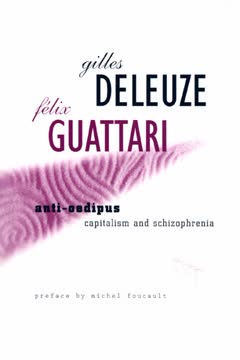
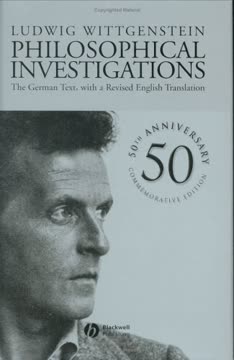
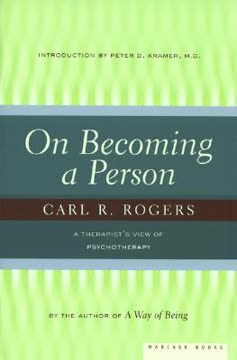
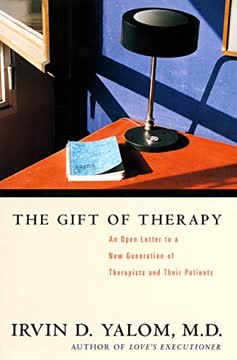
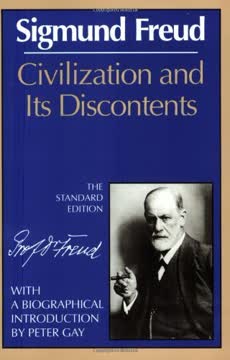
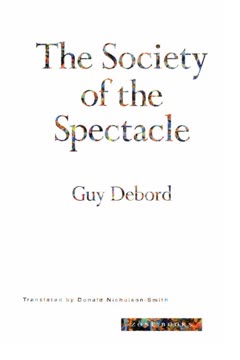
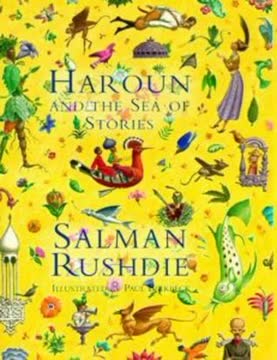
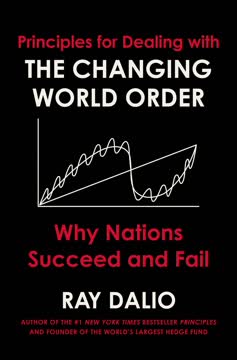
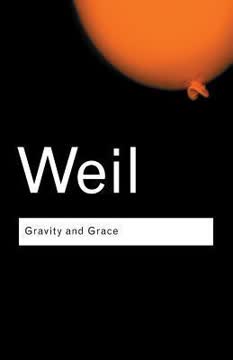
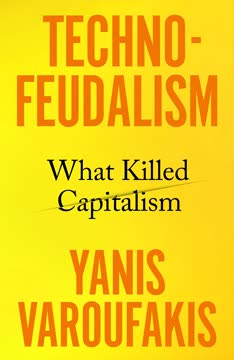
Download PDF
Download EPUB
.epub digital book format is ideal for reading ebooks on phones, tablets, and e-readers.
